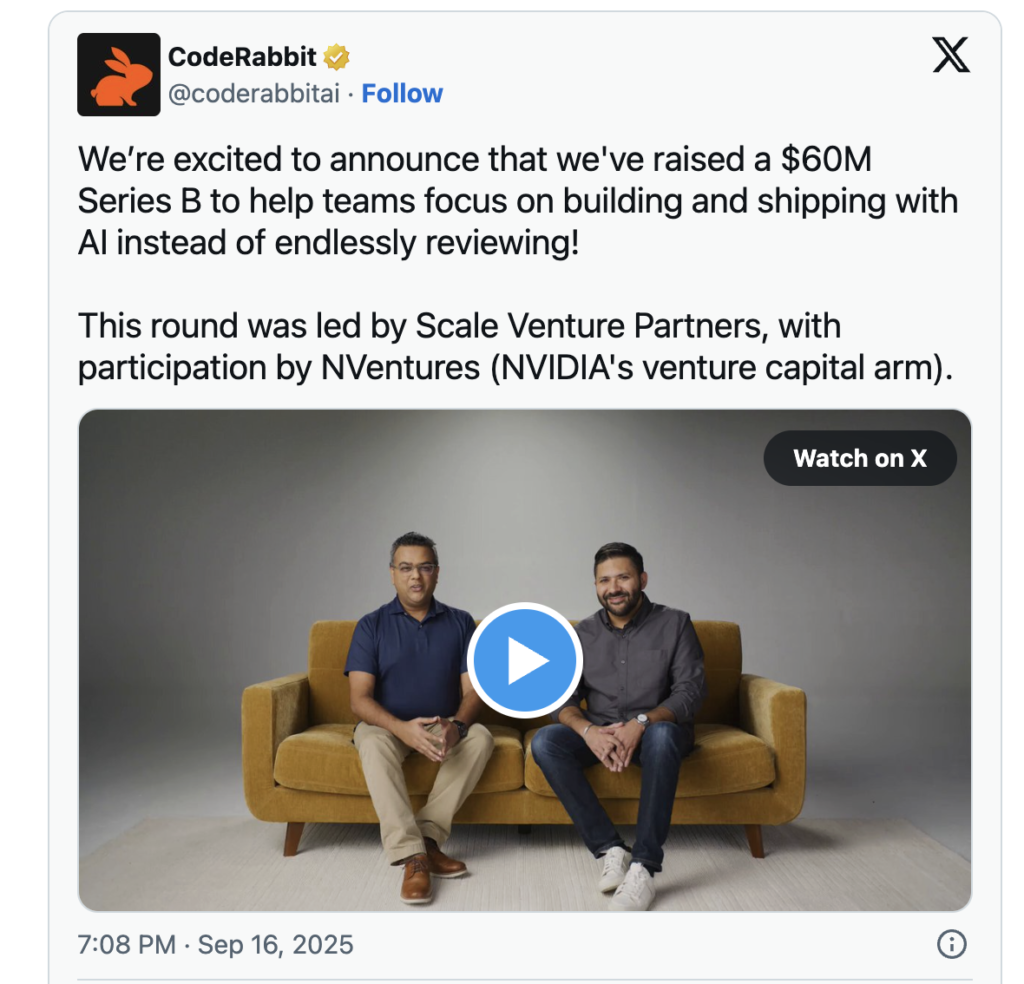- What is Business as Usual (BAU)? - October 8, 2025
- How Slack Grew to 10M Users Without Ads: Complete Growth Blueprint - October 8, 2025
- Top Startups in Kerala 2025 - September 26, 2025
The AI development tools market just witnessed a seismic shift. CodeRabbit, the pioneer of AI-powered code reviews, secured a massive $60 million Series B funding round led by Scale Venture Partners. But this isn’t just another funding announcement—it’s a masterclass in identifying and solving the right problem at exactly the right time.

Problem Most AI Startups Are Missing
While every tech company races to build AI coding assistants that generate code faster, CodeRabbit identified a critical gap: quality assurance bottlenecks.
The company’s CEO, Harjot Gill, put it perfectly: “AI-generated code is here to stay, but speed without a centralized knowledge base and an independent governance layer is a recipe for disaster.”
This insight reveals a fundamental truth about AI-powered industries: the first wave creates quantity, but the real opportunity lies in quality and governance.
“Vibe Coding” Phenomenon: A Market Timing Masterclass
CodeRabbit didn’t just stumble into success—they systematically positioned themselves for the “vibe coding” era. As AI tools like GitHub Copilot, Cursor, and Claude Code enable developers to generate code at unprecedented speeds, a new problem emerged: human reviewers simply can’t keep pace with AI-generated output.
The numbers tell the story:
- Organizations using AI coding tools generate significantly more code volume
- Traditional peer review processes haven’t scaled to match this velocity
- The Linux Foundation reported a 25% reduction in code review time after implementing CodeRabbit
This timing strategy offers a crucial lesson for AI startups: identify the secondary problems that emerge from AI adoption, not just the primary use cases.
Revenue Growth That Validates Product-Market Fit
CodeRabbit’s growth metrics demonstrate textbook product-market fit indicators:
- 10x revenue growth in the past year
- 8,000+ paying customers including major enterprises like Groupon and Chegg
- 100,000+ open-source projects using their platform
- #1 AI app on GitHub Marketplace
- Headcount doubled in under a quarter
These aren’t vanity metrics—they’re validation signals that CodeRabbit solved a genuine pain point for a rapidly expanding market.
Context Engineering Competitive Moat
What makes CodeRabbit’s approach particularly strategic is their “context engineering” methodology. Unlike competitors that rely on basic pattern matching, CodeRabbit’s AI gathers intelligence from dozens of sources:
- Custom review instructions and code graphs
- Historical pull requests and architectural documents
- Jira and Linear tickets
- Coding agent guidelines
- Feature requirements and engineering docs
This comprehensive approach creates what we call a data moat—the more a development team uses CodeRabbit, the more contextually aware and valuable it becomes, increasing switching costs.
Strategic Partnerships: The OpenAI Advantage
CodeRabbit’s early adoption of GPT-5 represents another strategic positioning move. CodeRabbit is one of the first to adopt GPT-5, harnessing the model’s industry-leading reasoning capabilities to deliver state-of-the-art AI code reviews.
Key takeaway for startups: Being an early partner with major AI providers can provide both technical advantages and powerful social proof for fundraising.
Full-Stack Integration Strategy
Rather than building a standalone tool, CodeRabbit pursued comprehensive integration across the development lifecycle:
- Command Line Interface for terminal-native workflows
- IDE integrations with VS Code, Cursor, and Windsurf
- Git platform compatibility with GitHub, GitLab, Azure DevOps, and Bitbucket
- AI agent integration with major coding assistants
This ecosystem approach eliminates context switching and creates multiple touchpoints with users, increasing engagement and retention.
What This Means for AI Startup Founders
CodeRabbit’s success offers several actionable insights for AI entrepreneurs:
1. Target the Quality Gap
As AI tools mature, focus on quality assurance, governance, and reliability layers rather than just speed improvements.
2. Build Context Moats
Create systems that become more valuable with usage by leveraging proprietary data and learning from user behavior patterns.
3. Time Your Market Entry
Look for secondary problems that emerge from AI adoption waves, not just the obvious first-order opportunities.
4. Pursue Ecosystem Integration
Build comprehensive integrations rather than standalone tools to maximize user engagement and switching costs.
5. Validate with Enterprise Metrics
Focus on metrics that demonstrate genuine business value: time savings, error reduction, and productivity improvements.
Broader Market Implications
With NVIDIA Ventures (NVentures) participating in the round, CodeRabbit’s success signals institutional confidence in AI development infrastructure. The code quality assurance market, estimated at $3B+ with 18% CAGR growth, represents a massive opportunity for startups that can navigate the quality-vs-speed challenge.
Key Questions for Your AI Startup Strategy
As you evaluate your own AI venture, consider these strategic questions inspired by CodeRabbit’s approach:
- What secondary problems will emerge as your target AI tools achieve mainstream adoption?
- How can you build proprietary data moats that strengthen with user engagement?
- Which ecosystem integrations would make your solution indispensable rather than optional?
- What enterprise-grade metrics can you optimize for that directly impact business outcomes?
Bottom Line
CodeRabbit’s $60M Series B isn’t just about one company’s success—it’s a blueprint for building sustainable competitive advantages in the AI era. By focusing on quality over speed, context over convenience, and integration over isolation, they’ve created a business model that scales with the problems it solves.
The lesson for startup founders is clear: in rapidly evolving AI markets, the biggest opportunities often lie not in doing what everyone else does faster, but in solving the problems that faster solutions create.

